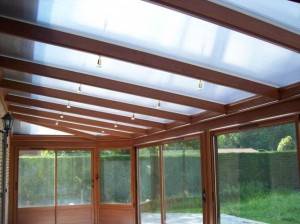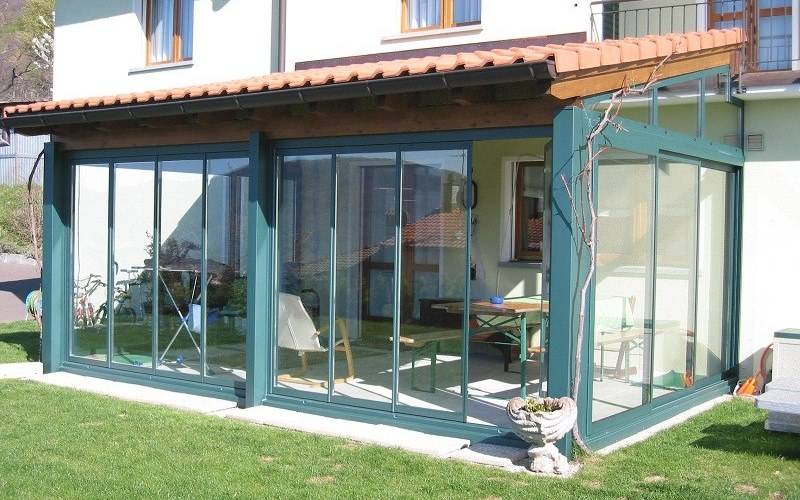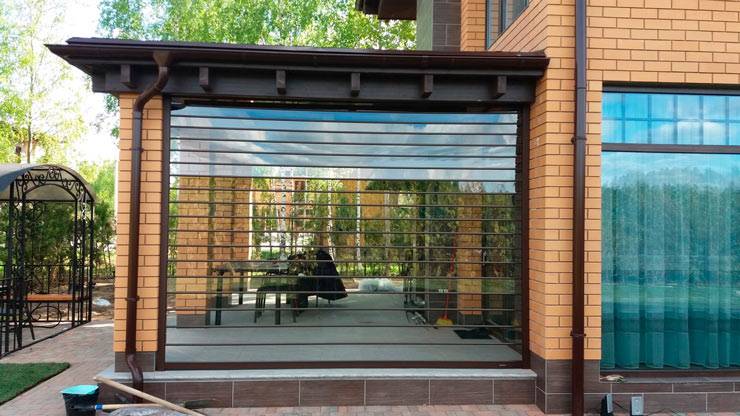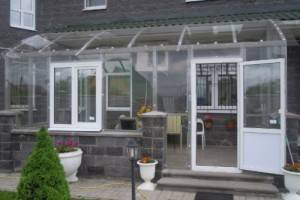Features of polycarbonate as a material for glazing
 Polycarbonate is a sheet material made from polymers with various additives.
Polycarbonate is a sheet material made from polymers with various additives.
In construction, it is widely used as a translucent material for glazing, which has a number of advantages:
- high strength, impact strength, resistance to wind loads - polycarbonate is quite difficult to break, and when broken, it does not fly into shards with sharp edges;
- the light weight of this material allows you to reduce the cost of installation, arrangement of the foundation;
- polycarbonate is a fireproof material;
- environmentally friendly, hypoallergenic, safe for human health material that does not emit toxic compounds;
- perfectly withstands frost, heat, and temperature changes;
- in terms of thermal insulation characteristics, a single polycarbonate sheet is comparable to a glass unit, and also provides good sound insulation;
- has high transparency, while it can be tinted to reduce light transmission or painted in different colors, which makes it possible to implement a variety of design solutions;
- has high plasticity, can bend without heating, which allows you to create curved glazing;
- resistant to chemicals;
- provides optimal transmission of useful rays of the spectrum, a high degree of protection against ultraviolet radiation, partial delay of infrared radiation;
- Polycarbonate for outdoor use retains all its properties when exposed to sunlight, since it has a UV protection coating.
It is not surprising that when choosing a material for glazing a veranda, many people opt for polycarbonate.
Glazing of the veranda with polycarbonate is an opportunity, at low cost, to give the veranda an extremely effective look, provide reliable protection from hard UV radiation, and keep the room warm as much as possible.
Veranda glazing recommendations
- If the veranda is made of cellular polycarbonate, then the air channels must be located vertically, the material must also be bent in the direction of the channels, and not across.
- Open sections of cellular polycarbonate must be covered with profiles or a special tape on an aluminum base, but not with tape.
- In the lower part of the sheets, closer to the frame, you need to make small holes for drainage.
- Polycarbonate has a fairly significant thermal expansion, so the sheets should not be fixed rigidly, thermal washers with rubber gaskets compensate for the expansion of the material when heated.
- You can use a jigsaw or circular saw to cut the sheets.
- The protective film is removed from the polycarbonate after all installation work has been completed.
For glazing the veranda, you can use honeycomb or monolithic polycarbonate, which is 200 times stronger than glass in its strength. This material is light in weight and lends itself well to processing, its installation can be done by hand.
Algorithm for mounting windows
After installing the supporting frame, we proceed to the installation of windows:
- Anchors are screwed into the pre-marked places of the window frame, forming a suspension. One anchor is located on the frame at the top, the other two are on the sides. A special profile is inserted into the window opening of the frame, where the frame will be installed, which is fastened with dowels inserted into holes with a diameter of 8 mm.
- Using a plumb line, a building level and wedges for greater accuracy of installation, a window frame is anchored to the profile on the frame.
- The correspondence of the seats of the window sill and the frame is determined. Using a file and a hacksaw, the mating elements are mutually adjusted.
- To create rigidity under the windowsill, a board is fixed on brackets or wedges.
- Caps are installed along the edges of the window sill.
- The building level checks the correct installation of the frame.
- All gaps are sealed with polyurethane foam. Excess cured foam can be removed with a clerical knife.
Sliding
With a sliding design, the frames move along rails, saving space, but reducing tightness due to wear of the mating elements.
Polycarbonate sliding windows will save space
The glazing process consists of the following operations:
- The frame is mounted on a profile fixed to the frame.
- The part of the sheet intended for longitudinal movement is inserted into the guides mounted on the frame together with the profile.
- The accuracy of the installation is checked by the level.
- The frame is attached to the frame with anchors.
- Installation of the window sill.
- Polyurethane foam removes gaps.
- The remaining foam is removed.
- Slopes are installed.
Swing
The design of hinged windows is traditional - it is a frame consisting of hinged sashes.
Hinged windows made of polycarbonate are considered the most common among the population.
Installation technology is as follows:
- A metal profile is attached to the frame.
- The hinges for the sash are screwed to the profile.
- The assembly of the frame elements and polycarbonate sheet is carried out.
- The leaves are installed on hinges in the frame opening.
- The accuracy of the installation of the leaves is checked by the level.
- Installation of the window sill.
- Polyurethane foam removes gaps.
- The remaining foam is removed.
Deaf
Fixed windows are simple in design. Installation is straightforward:
- The frame is mounted on a profile fixed to the frame.
- The accuracy of the installation is checked by the level.
- The frames are attached to the frame with anchors.
- Installation of the window sill.
- Polyurethane foam removes gaps.
- The remaining foam is removed.
- Slopes are installed.
But whatever construction of carbonate windows for installation on the veranda you choose, the type of construction is aesthetic, the pleasure of working with such material is guaranteed.
Glazing with aluminum structures is our choice

Glazing of the veranda and terrace with an aluminum profile can be cold and warm. For cold glazing, aluminum facade systems and frameless glazing are used.
The option of warm glazing for verandas and terraces involves the use of wooden and plastic windows with profiles from various manufacturers, as well as facade glazing equipped with thermal breaks, due to which the rate of heat retention in the room is increased.
One of the most popular is the aluminum frame glazing method. What are the advantages of glazing a veranda with an aluminum profile?
- Aluminum profile veranda saves budget. Alu profile is much cheaper than other types of terrace and veranda glazing. The minimal and easy maintenance make this material the most popular among builders.
- Various aluminum structures allow you to cover any area with glass. It will perfectly cope with floor-to-ceiling panoramic glazing.
- The aluminum glazing of the veranda has a high flow rate. And thanks to the sliding structure, on warm days, you can transform the veranda into an open terrace and enjoy nature and fresh air.
- The light weight of the structures allows for aluminum glazing of terraces and verandas, even in those places where structures made of plastic or wood are contraindicated. An aluminum veranda is practical. the material does not rot, does not rust and retains its original appearance for a long time.
Advantages and disadvantages of transparent roller shutters
Today, roller shutters made of transparent materials are considered the latest model. Both glass and polycarbonate look equally good and do their basic functions. However, like all things, they are not perfect.Before making a final decision, you should familiarize yourself in more detail with the advantages and disadvantages of the designs.
- The main advantages of transparent roller shutters:
- reliability;
- long service life;
- ease of installation;
- ease of care and maintenance;
- in the event of a breakdown, parts are easily changed;
- high decorativeness and fire safety;
- providing additional noise insulation;
- low susceptibility to corrosion.

- Among the shortcomings, the following aspects can be distinguished:
- high cost of structures;
- in terms of resistance to burglary, they are inferior to metal gratings;
- in case of icing, the blocking sensor will work, which will lead to the need to debug the drive by the master;
- the need to carry out an annual inspection in order to eliminate malfunctions and adjustments together with a specialist.
Did you know? Roller blinds let only 10% of the sunlight into the room, and, accordingly, much less heat enters. In hot weather, this device can be an excellent substitute for an air conditioner.
Any veranda, terrace or gazebo equipped with transparent roller shutters will look interesting and unusual. A similar structure can be mounted even in an open room. Its installation takes no more time and effort than a standard plastic one, and the roller shutters look much better.
Prices for transparent polycarbonate roller shutters
The price of transparent roller shutters depends on several factors:
- canvas size,
- type of canvas,
- type of lamellae,
- lifting mechanism design,
- Colour.
If necessary, you can also order the production of combined roller shutters, in which only part of the lamellas will be replaced with transparent elements. The high level of technical support of our production and extensive experience in the field of automated systems allows the craftsmen of "Brami" LLC to fulfill any orders at a high level.
To order translucent roller shutters, please contact us by phone.
Views
There are two types of transparent roller shutters. They differ in the type of material used to create the lamellas. The first type is made of glass, the second is made of polycarbonate. Before deciding to install such a design, you should study in more detail the features of each option.
Glass
For the production of this variation, tempered glass with high strength characteristics is used. Such material provides more reliable protection against natural disasters. It is equipped with a lifting mechanism, with the help of which the entire canvas is hidden in a box or opens along the perimeter of the window space. The design is highly reliable, but rather heavy, which complicates its installation.

Polycarbonate
Polycarbonate is a very lightweight material. Today it is used in many areas of human activity.
Roller shutters made of the material under consideration can be installed in any type of room, including open ones, they let in 90% of the sunlight, perfectly protect from wind and rain.
This design is light enough that its installation will not be a problem.

Installation of roller shutters
All manipulations at the initial stage are carried out as for standard roller shutters, that is, the box is mounted. The first step is to check the system and prepare the guides.
Did you know? The word "blinds" in translation from French means "envy, jealousy". The device received this name due to the fact that it allows you to observe any object, while remaining invisible.
Step-by-step execution of actions:
- Place the box on a flat surface and make markings on it. To mark the first point, you need to step back from the edge of 10 cm, all subsequent ones are set in increments of 40-50 cm.
- Convert the marked places into holes using an 8 mm drill.
- Attach the roller shutter cover to the wall of the structure and make 2 holes 4 mm in size at the edges for mounting rivets.
- Mark the fixing points to the wall on the side and drill them with an 8 mm drill.
- Assemble the structure by connecting the box with the guides.
- Carry out the marking of the opening for the installation of the canvas: attach the assembled system to the wall, transfer all points from it to the partition, not forgetting to check first the coincidence of the diagonals. Make holes at the specified points. Place dowels in them. If necessary, make openings in the lower part of the wall to fix the locking parts.
- After all of the above, proceed to the direct installation of the frame. To do this, remove the film from the canvas. Check the location of the holes on the box. They fasten all the parts together with self-tapping screws.
- Next, you need to fix the control system. To do this, markings are made on the wall, then holes are drilled and the tape layer with guides is fixed.
- Spacer rings are fixed in the holes of the box from above. After that, they proceed to the installation of the crossbars on both sides of the panel, which at this moment is wrapped around the shaft and led into the guides. Now you can fix the traction springs, which are mounted inside the shaft holes.
- After finishing the work, the box is closed, the remnants of the protective film are removed. After that, the plugs are mounted and everything is sealed with silicone.
- The final step will be to connect the mechanism with which the canvas will roll up and unfold.
Drive classification
Today you can buy transparent roller shutters in white, milky, gray, brown and beige shades. According to their intended purpose, there are protective, decorative, light-absorbing, noise and heat-insulating models. As for the control mechanism, there are mechanical and automatic polycarbonate roller shutters.
Spring-inertial, belt-inertial, gear-cord and cord-collar drives are manually adjusted. They differ in this type of design with a permissible load. So, for light roller shutters weighing 15–20 kg, you can use a gear-cord or belt-inertial drive. For heavy structures that can withstand a load of up to 100 kg, spring-inertial control units are used.
The most expensive option is the electric drive. Maximum load - no more than 200 kg. Control is carried out automatically using buttons, a magnetic card or a combination of numbers on the remote control.

The position of the roller shutters is adjusted using special drives
Choice: Cellular or Monolithic
 Many brands of polycarbonate are produced, which have their own characteristics.
Many brands of polycarbonate are produced, which have their own characteristics.
The assortment of each manufacturer includes material of different thickness, color, transparency.
But the most significant is the difference between the two varieties of polycarbonate, monolithic and honeycomb.
Monolithic polycarbonate:
has a continuous homogeneous structure without cells;
almost indistinguishable from glass in appearance;
anti-vandal material, superior to cellular strength characteristics;
traumatic, when struck, a dent is formed in it, but the fragments do not fly away;
requires careful handling during transportation and installation due to susceptibility to scratching (more expensive varieties of monolithic polycarbonate with additional protection against scratches are produced);
costs more than a cell phone.
Cellular polycarbonate:
- it is created from 2 or more sheets connected by internal partitions that play the role of stiffeners, has a cellular structure;
- due to the presence of air channels, it has higher heat and sound insulating characteristics;
- more flexible;
- lighter than monolithic;
- a wider color gamut is usually available;
- cheaper because less raw materials are used to make it.
Cellular polycarbonate can have cells of different shapes, a different number of layers.
It is necessary to take into account aesthetic preferences - cellular and monolithic polycarbonate look different. For outdoor work, which includes the glazing of the veranda, it is imperative to choose a material with UV protection.
Polycarbonate sheets have different thicknesses; for glazing the veranda, the material with a thickness of 8-10 mm is optimal, if the polycarbonate is honeycomb, two-layer is preferable. Issued cellular polycarbonate sheets 2.1 m wide, 6 or 12 m long, monolithic - 2.05 m wide, 3.05 or 6 m long.
The following brands of polycarbonate are presented on the domestic market:
- BEROLUX (Yug-Oil-Plast) - two- and three-layer cellular polycarbonate, transparent, colored and with the effect of blinds (transparent walls and colored internal partitions) 3.5-10 mm thick, warranty period of 10 years.
- NOVATTRO (SafPlast) - cellular polycarbonate with a different number of layers (1, 2 and 4), different channel shapes - triangular, rectangular, trapezoidal, 4-32 mm thick, 12 colors; monolithic with a smooth and corrugated surface, 1-12 mm thick, a warranty period of 14 years.
- POLYGAL (Polygal Vostok under the license of Israel) - honeycomb, 4-40 mm thick, 8 colors; monolithic 2-10 mm thick, 3 colors. The best solution for glazing a veranda would be Polygal comfort, a material with a pigment that absorbs thermal radiation;
- CARBOGLASS (Karboglass) - cellular polycarbonate with a different structure and shape of channels, has 1-4 layers, thickness 4-25 mm, 14 colors; monolithic with a thickness of 1.5-14 mm, 3 basic colors plus 12 on request.
- Kronos (Kronos-trade) - cellular polycarbonate with 1-4 layers, triangular, rectangular and hexagonal channels, 3.3-25 mm thick, 8 colors.
Features of polycarbonate shutters
When building a terrace, veranda or gazebo, it is necessary to carefully consider each structural element.
It is important to pay due attention to the design of window openings. Leaving windows fully open is impractical as wind and rain will lead to accumulation of dirt and debris indoors
The optimal solution to a pressing problem is roller shutters. Roller shutters made of aluminum and steel protect the building from intruders. Therefore, they are used to equip shops and garages.
Glass shutters are distinguished by good noise and heat insulation, look harmonious and let in sunlight. However, the glass can crack or shatter when strong gusts of wind, falling branches or impacts.

Polycarbonate shutters are much stronger than glass
For seasonal buildings it is recommended to use transparent polycarbonate roller shutters. The advantages of polycarbonate shutters include:
- light transmission from 90 to 95%;
- economical consumption of electricity;
- protection from direct exposure to ultraviolet rays;
- good indicators of fire resistance;
- resistance to mechanical and chemical influences outside and inside;
- high burglar resistance;
- the aesthetic appeal of the building;
- protection from dust, debris and dirt during precipitation and strong gusts of wind;
- ease of installation and ease of use.
Monolithic polycarbonate is suitable for arranging window and doorways of terraces, open verandas and gazebos. The minimum sheet thickness is 4 mm. To strengthen the structure, it is necessary to use aluminum profile connecting elements.
Frameless veranda glazing is a novelty available to everyone

It is also worth saying a few words about a fairly new way of mounting frames - frameless glazing. This glazing method is quite expensive when compared to aluminum profile glazing, but it is worth it.
The frameless sliding glazing of the veranda allows you to create a light, transparent and floating structure, to expand the view. Also, the frameless glazing method is ideal for terraces that are located separately from the house. Mounting frameless glass retains natural light and does not interfere with the panoramic view of the area.
Read more: Frameless glazing of balconies, loggias and terraces
At first glance, the frameless glazing of the veranda may seem fragile and not reliable. But this is not the case. For such glazing, only thick tempered glass is used, which is difficult to break. For frameless glazing, high-quality fittings from leading manufacturers are used.
Frameless systems have increased protection against burglary, are easy to operate, do not require repair and can delight owners for many years.
As we said above, there are many ways to glaze a veranda. For example, warm glazing with plastic double-glazed windows will allow you to stay on the veranda even in cool weather. However, due to the heavy construction, PVC windows are not always technically feasible. Wooden windows for the veranda are expensive and also have some peculiarities in the installation. But the beauty, environmental friendliness and naturalness of the profile speaks in their favor.
Of course, the main factor when choosing glazing is functionality, cost and durability. Do not forget about the aesthetic appearance that will turn out in the end.
Preparing for installation
In order for the roller shutters to completely cover the window or doorway, it is necessary to correctly calculate the dimensions of the finished structure. Use a construction tape to measure the width and the height of the window or door... Additional amplifiers will be required for widths over 2 m. If the width of the window opening exceeds 5 m, you cannot do without the installation of reinforcing aluminum profiles.
During installation, you will need the following set of tools:
- centimeter tape or construction tape;
- marking pen;
- sharpened knife;
- screwdriver;
- fasteners;
- puncher;
- drill with a set of drills.
What are the advantages of roller shutters with transparent slats?
A number of advantages of translucent roller shutters are due to their ergonomic design. The advantages include ease of installation and resistance to moisture. Roller shutters can be installed at any height, which allows you to save free space in the room and regulate its illumination. No Drop water-repellent coating protects against moisture by converting condensation into small droplets.
Other benefits:
- Sun protection,
- saving electricity,
- additional protection of windows against burglary,
- the ability to create an original design.
Installing a transparent roller shutter is a great way to protect your room from bright sunlight. The shutter diffuses light, prevents heat build-up and reduces UV penetration through a special coating. It is co-extruded (two-material extrusion).
The benefits of roller shutters are noticeable not only in the hot summer. For example, in spring or autumn, they will protect against rain noise. And in winter they will contribute to protecting the premises from the cold.
Roller shutters also help to save energy, which is spent due to the switched on air conditioner or fan. Shutters reduce the heating of the room, therefore, it is not necessary to turn on air conditioning devices so often. Well, due to the transparency of the films on the shutters, artificial lighting can be used less often at certain hours.
Like many other roller shutters, translucent models provide additional protection against illegal entry into the room or various damage to windows. In terms of strength, polycarbonate is comparable to aluminum, so there is no need to worry about the resistance of roller shutters to all kinds of damage.
The decorative qualities of transparent roller shutters allow you to create truly original design solutions. Thanks to the wide selection of different colors and the correct shapes of the elements, roller shutters can be used in combination with any finishing materials, be it wood, fabric, steel or porcelain stoneware.
The shutter fabric is formed from two types of lamellas - white and gray. The difference between the two is the degree of shading provided.
Practicality of polycarbonate windows
Polycarbonate is an excellent replacement for glass. This is a worthy alternative to plastic insulating glass units, since it differs in quality characteristics:
- Increased toughness and strength.
- The low specific gravity allows the foundation to be lightweight.
- Fire and environmentally friendly.
- Temperature changes do not affect the quality of the material.
- High heat and sound insulation properties.
- Transparency and the ability to shade expand the options for implementing design ideas.
- Plasticity contributes to the flexibility of the material without heating.
- High resistance to aggressive environments and sunlight.
- It does not transmit ultraviolet rays, and delays infrared rays.
- The cost is cheaper than glass.
Disadvantages:
- Weakly resists abrasives. Easy to scratch.
- It reacts to the effects of low and high temperatures by a significant change in its size. This factor should be taken into account during installation, having planned in advance the place for the thermal gap.
